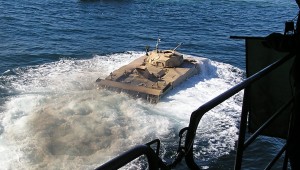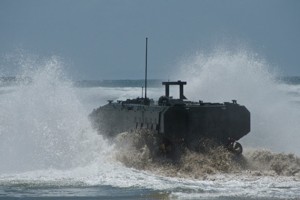 To continue the discussion of Marine Corps amphibious warfare, I turn to the amphibious tank, an asset the Marines have been trying to procure since the early days of Operational Maneuver From the Sea (OMFTS). Now, let me be frank– I like the idea of an amphibious tank, and believe a turn towards the Pacific demands an amphibious asset capable of traversing coral reefs, clambering ashore and, if required, providing fire support for engaged Marines. If we are looking towards a future of delta and island operations, it would certainly be nice to have something armored able move through a delta or up a river to better support Marine Corps operations close to water.
To continue the discussion of Marine Corps amphibious warfare, I turn to the amphibious tank, an asset the Marines have been trying to procure since the early days of Operational Maneuver From the Sea (OMFTS). Now, let me be frank– I like the idea of an amphibious tank, and believe a turn towards the Pacific demands an amphibious asset capable of traversing coral reefs, clambering ashore and, if required, providing fire support for engaged Marines. If we are looking towards a future of delta and island operations, it would certainly be nice to have something armored able move through a delta or up a river to better support Marine Corps operations close to water.
That said, a product sprung from the fever swamps of the Reagan-era Cold War is inappropriate for the Pacific. Let me quote from a Proceedings essay I wrote a few years ago regarding the now-cancelled Expeditionary Fighting Vehicle:
As conceived, the fully amphibious Expeditionary Fighting Vehicle (EFV) would shuttle 17 equipped Marines (plus three crew) and a 30-mm MK 44 Bushmaster cannon to any beach within 75 miles of embarkation. Capable of racing from amphibious vessels to the beach at a blistering 25 knots, the 76,000-pound fighting vehicle would then emerge from the surf to charge far inland, matching the mobility of an M-1 Abrams main battle tank.
This mission was first articulated during the Cold War, back in the days when Marines were planning to defend NATO’s northern flank by landing on the tundra of the heavily-defended Kola Peninsula. The EFV was to fight on land, outmaneuvering relatively static Soviet formations. By 1991, the original mission had evaporated, but subsequent revisions of Marine Corps amphibious assault doctrine, embodied in “Operational Maneuver From the Sea” (OMFTS), kept the procurement focus on ever-faster, over-the-horizon means of ship-to-shore transit. Offering no new design guidance regarding alternative operations-other-than-war or military operations in urban terrain, OMFTS, in essence, froze the EFV concept. So the vehicle remained an expensive, highly specialized tool for maneuver—storming the missile-bristling Kola Peninsulas of the next big war.
As we can see, the EFV was some sort of strange hybrid, blending blitzkrieg tactics with a single amphibious assault–a “land one time and head inland” type of asset. It was an ambitious project, and it failed–but not before the EFV–part of the USMC’s “must have” OMFTS triad (MV-22, the LCAC and EFV)–gobbled up billions in funding, only to be sent to an ignominious end as a cancelled program.
But rather than sit back and rethink things after the EFV was cancelled, the Marine Corps just went right back to the well, proposing a non-alternative alternative–the Amphibious Combat Vehicle (ACV).
Here’s the 2011 Amphibious Combat Vehicle RFI:
While the ideal capability would be for the vehicle to transit from well over the horizon at a high rate of speed, this may prove to be unaffordable. At a minimum, the vehicle must be able to autonomously deliver a Marine infantry squad from amphibious shipping at launch distances at, or beyond the horizon (minimum of 12 miles) with a speed to enable the element of surprise in the buildup ashore, and provide combat-ready Marines at the objective. The vehicle must be able to execute a seamless transition from sea to land and maneuver with a mechanized task force for sustained operations ashore.
Sigh. Nothing has changed. The Marines have dug in.
Despite the changing world, the Marine Corps is still asking for a tracked land warfare vehicle, with, essentially, specs borne out of storming the Cold War-era Kola Peninsula–Ok, maybe now the Marines can live with something that swims a little slower, but still, the Marine Corps is irrevocably wedded to a vision of conducting amphibious landings that transform seamlessly into grand-scale, hard-charging ground warfare of the type best practiced on Russian tundra or a Middle Eastern desert.
Perfect for an organization turning attention to the Pacific, right?
Wrong. The first issue is geography–Where in Oceania are Marines going to need (or even be able) to exploit M1A1-like mobility? Look at the potential points of conflict in the Pacific–there is no chance of employing an OMFTS strategy on the Ryukyus. Zero. None. And there’s little chance of employing the full-speed mobility of an M1A1 clone in any of the Pacific areas where it might be in U.S. interest to land armor in the foreseeable future. Like it or not, the Pacific just ain’t tank country.
It’s amphibious tank country. Big difference.
In the Pacific, amphibious tanks are going to be called upon to conduct a far larger set of amphibious operations than we presently expect. The original OMFTS doctrine–land once and then that armored platform is basically fully committed to a wide-open land war–isn’t going to happen. In the Pacific, these platforms will be working in the water day in and day out, in swampy areas, river deltas or…at worst, probing the maritime fringes of urban environments.
Second problem is strategy. OMFTS-based strategy is all about landing where the enemy isn’t, and then moving quickly inland for hundreds of miles. That, in itself, puts the idea of armored tanks–justified as devices for “kicking in the door” at the beach–into question. Look. If any OMFTS-inspired “maneuver plan” involving armor is simply about finding an easy way to unleash the tanks’ awesome ground mobility, then the distance between the landing site and the objective is a secondary concern. So why not use ISR to find an out-of the way, unprotected beach suitable for legacy landing craft and then land traditional “optimized for ground warfare” craft there? Then the tanks will take care of themselves, right?….Right?
Sigh.
The Marine Corps must come to terms with the unpopular idea that amphibious tanks are a niche capability, meant to either support Marines in landing upon opposed beaches/sea features or provide support to USMC missions near water. Don’t optimize for land war. Optimize the platform to support, if necessary, favorable conditions for the rapid insertion of equipment specialized for land warfare.
So, if I were in a position to tell the Marines what to do, I would ask: 
- Where, exactly, does the Marine Corps see the employment of an amphibious tank to be likely? Is there any reason why a conventional M1A1 land-warfare-ready tank will not suffice? Or a new wheeled Marine Personnel Carrier (MPC)?
- Provide a detailed assessment of all areas in the Pacific where 1) a 80,000-ton Abrams tank can operate and 2) a lighter wheeled combat vehicle can operate. (Does an MPC-like vehicle give the USMC a larger geographical “reach”?)
- Evaluate what would be required to support the direct disembarkation of future amphibious vehicles from connectors–LCUs, LCACs, JHSVs, or other platforms–that lack a well deck. Could future amphibious vehicles be crafted to swim off non-well-deck vessels (particularly vessels that can make a quick or stealthy approach)? In island environments does the USMC really need to worry about non-permissive re-embarkation?
- When will a rival state be able to quickly deploy a tactical overmatch in certain scenarios likely to develop into an amphibious confrontation (Reef/small island occupations; Overstaying post HA/DR activities; etc.)? Do we really need something in a hurry, and if so, does it need to be tracked?
- What would a armored vehicle, optimized for water-borne operations, look like? What would the requirements be? Would the need for speed return? What about max sea state?
- What do our Pacific-based allies (Japan, Australia, Vietnam, Korea, Singapore, Philippines, etc.) feel they need? Is there a chance to work together to create a regional solution?
I think an armored vehicle would be a useful piece of kit for the USMC. However, most of the research money spent to date has been focused upon designing a swimming piece of Cold War kit, and the USMC seems loathe to sink their already-sunk costs and take a new approach. If they stay the course, then policymakers within the USMC and DOD must do a better job of explaining why we need to stick with it.
Unless there is a compelling case for urgency, my sense is that the less ambitious amphibious Marine Personnel Carrier (a wheeled APC–see the photo above) offers an easy 80% solution–and sufficient breathing space for the Marines to go back to the drawing board and reconsider alternatives.

{ 5 comments… read them below or add one }
Concur! Good to see you here Leesea..
I too like the L-CATs which BTW are in production for French Navy. The key distinction which our Marines would have to learn to live with is they are NOT fully amphibous (I say so what~)
There are already 120 mm auto cannon armed boats. Alutech I believe makes some
Love the Finnish proposal. What I’d really get a kick out of is an old strategy out of WWII, which was to put tanks aboard LCM/LCUs and then use ’em to provide fire support (something that was echoed in Korea, Vietnam and Grenada)….They’ve even been used in an anti-ship role–if I recall correctly, someplace in the Solomons, landing-craft mounted tanks even took on some Japanese barges and won. I talk a bit about that in my USNI Proceedings EFV essay.
Imagine how interesting it would be roll a NEMO-armed APC or two aboard a humble LCU in the Gulf someplace (OK, maybe with some additional sensor integration)….I mean, if I were a small-boat swarm, I’d sure think twice before charging something like that…
I am with El Sid on this, for operating in mixed environment riverine, delta, harbours and near offshore you need a mix of equipment, including hovercraft.
Have you seen the Finnish fast landing craft equipped with a 120mm NEMO mortar that can also operate in direct fire mode, or putting a Hellfire/APWKS type system on, well, pretty much anything, be that boat, hovercraft or amphibious vehicle
“In the Pacific, these platforms will be working in the water day in and day out, in swampy areas, river deltas”
Am I the only one who sees this emphasis on swamp/reefs and think “hovertank”? Something like a Griffon 2400TD derivative with a CT-40 or 120mm mortar?
Of course, that won’t be good enough for the USMC, they’ll want a derivative of the $55m SSC with additional armour and heavy weaponry…..